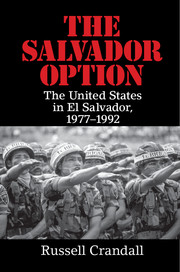Book contents
- Frontmatter
- Dedication
- Epigraph
- Contents
- List of Figures
- List of Organizations
- Acknowledgments
- 1 Introduction
- PART ONE EL SALVADOR IN THE COLD WAR
- PART TWO JIMMY CARTER
- 7 Revolution and Counterinsurgency in Guatemala
- 8 Mass Organizations
- 9 Carter Arrives
- 10 Carter and the Sandinista Revolution in Nicaragua, 1979
- 11 An October Coup
- 12 Carter Engages Salvador
- 13 Archbishop Romero
- 14 Land
- 15 The American Churchwomen
- 16 Arming the Rebels
- 17 Guerrilla Final Offensive, January 1981
- 18 Death Squads
- PART THREE RONALD REAGAN
- PART FOUR GEORGE H. W. BUSH
- PART FIVE POSTWAR
- Notes
- Bibliography
- Index
17 - Guerrilla Final Offensive, January 1981
from PART TWO - JIMMY CARTER
Published online by Cambridge University Press: 05 June 2016
- Frontmatter
- Dedication
- Epigraph
- Contents
- List of Figures
- List of Organizations
- Acknowledgments
- 1 Introduction
- PART ONE EL SALVADOR IN THE COLD WAR
- PART TWO JIMMY CARTER
- 7 Revolution and Counterinsurgency in Guatemala
- 8 Mass Organizations
- 9 Carter Arrives
- 10 Carter and the Sandinista Revolution in Nicaragua, 1979
- 11 An October Coup
- 12 Carter Engages Salvador
- 13 Archbishop Romero
- 14 Land
- 15 The American Churchwomen
- 16 Arming the Rebels
- 17 Guerrilla Final Offensive, January 1981
- 18 Death Squads
- PART THREE RONALD REAGAN
- PART FOUR GEORGE H. W. BUSH
- PART FIVE POSTWAR
- Notes
- Bibliography
- Index
Summary
This country is going to have violence, a massacre that has not even begun. Who did this? Communists? Capitalists? Oligarchs? Who knows? Nobody ever knows.
– A Salvadoran comments after his father's death, January 1981Mao said that the guerrillas live among the people like fish in water. But here it is the reverse, the army that lives with the people.
– Colonel Ricardo Pena, January 1981On January 10, 1981, the recently united FMLN announced the launch of its “Final Offensive” that lasted over the next three weeks:
At 5:00 this afternoon the offensive was launched. The enemy is lost; we have him surrounded. Popular injustice is at hand.…The General Command summons the people to set up local powers throughout the country, alternatives to the municipal authorities, and to erect barricades and to provide water to the popular combatants.…People of El Salvador, we have begun the national liberation. The moment has come to take to the streets.…The decisive hour has come to initiate the decisive insurrectional battles for the seizure of power.
More than 2,500 poorly trained guerrillas and a few hundred Cubans initiated scores of attacks against FAES positions. This was roughly the same number of forces that the Sandinistas had when they unleashed their operation to oust Somoza. Swollen with optimism after witnessing their comrade Sandinistas’ dramatic victory in Nicaragua less than two years earlier, the FMLN scheduled the offensive for early January so that they would be able to seize power before the hawkish Reagan administration took office a few weeks later.
Bolstered by several months of receiving clandestine shipments from Nicaragua, the guerrillas were now employing a variety of arms “never before used in El Salvador,” including M-16 rifles and M-79 grenade launchers. According to the dubious State Department, “they were a far cry from handguns, hunting rifles, shotguns, and homemade explosives,” which before had supposedly been the base of the guerrilla arsenal.
Within the first hours of battle on January 10, four San Salvador radio stations had been captured; the guerrillas used them to broadcast a taped message to rally the Salvadoran people behind their revolution, announcing that junta leader José Napoleón Duarte would soon be assassinated. “Hit-and-run street actions” appeared to be “everywhere,” one witness recalled. In the cities, buses were burned; in the countryside, rebels stopped buses and exhorted passengers to join the revolution.
- Type
- Chapter
- Information
- The Salvador OptionThe United States in El Salvador, 1977–1992, pp. 176 - 182Publisher: Cambridge University PressPrint publication year: 2016

